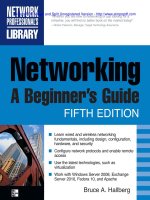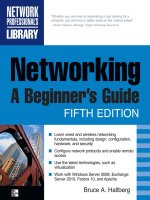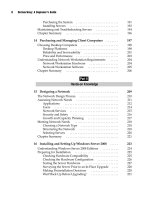Networking: A Beginner’s Guide Fifth Edition- P16 pptx
Bạn đang xem bản rút gọn của tài liệu. Xem và tải ngay bản đầy đủ của tài liệu tại đây (138.13 KB, 5 trang )
57
Chapter 4: Understanding Network Cabling
protocol on your computers, and try to ping another workstation in the complete
segment.) If they can log in, then you know the problem is further on along the cable.
Move to a new location, attach the extra terminator, and try again. Eventually, you
will find two nearby locations where the terminator will allow the network to work
in one spot but not in the next spot. You should find the cable problem somewhere
between those two node locations. This approach requires patience, but it works
fine in a pinch.
More troublesome still on coaxial networks is a problem that is causing poor
network performance, but not causing any nodes to actually disconnect from the
network. Such problems are often intermittent and not easy to find with a cable
scanner. When you have this type of problem, your best approach is to come up with
a test that can quickly tell you how fast the nodes are communicating with the network.
For example, you can time how long it takes to copy a particular file from the server.
Next, use a terminator to close off a large part of the segment and perform the test
again. Keep moving the terminator and retrying the test until you discover which part
of the cable slows down network performance on the segment. Then either replace all
those portions or narrow your search further. This type of problem is usually caused
by a poor connection in one of the male cable-end BNC connectors, although a flaky
T-connector or barrel connector can also be the culprit. It’s usually fastest—providing
you narrow the problem to a small enough area—to simply replace all the cable and
connectors in that location.
Having a second person help you troubleshoot coaxial cable problems makes the
job much easier. One person remains in a fixed location at one end of the segment
with a test computer, and the other person moves from location to location with a
terminator. While the mobile troubleshooter maps out parts of the segment with the
terminator, the stationary person can quickly test to see if any individual parts of
the segment prove to be a source of the problem (communicating via a cell phone or
portable radio).
TIP Before going to the trouble of pulling a new section of cable through the wall or replacing
various cables and connectors, try simply running an extra cable from one location to another, such
as out the door of one room, down the hallway, and into the room of another. Then test to see if this
“mapping out” of the suspect portion of the segment fixes the problem. If it does, go ahead and have
a new cable run in the walls. If the problem is still there, you need to look further before replacing
cable and connectors.
As a general rule, troubleshooting cable problems requires a careful, step-by-step
approach and patience. For coaxial cable systems, troubleshooting is made more
difficult because a lot of network users are breathing down your neck while you’re
trying to concentrate and find the problem. You’re lucky if you can find a coaxial
network problem and solve it within an hour. Some problems may take several hours
(or more) to resolve.
58
Networking: A Beginner’s Guide
Chapter Summary
In this chapter, you learned about network cable systems. It covered the major
topologies in which networks are wired, how CSMA/CD and token passing work,
what types of cables are commonly used, and how they should be installed. You also
learned some tips about selecting cabling contractors and troubleshooting network
cable problems.
The next chapter expands on this discussion by focusing on creating small office
or home office networks. As part of that discussion, you will also learn about wireless
networking.
59
Chapter 5
Home Networking
60
Networking: A Beginner’s Guide
A
lthough this book focuses on business networking, small office and home
office (SOHO) networking is growing in importance, and no introduction
to networking would be complete without at least of brief discussion of this
topic. This chapter provides an overview of how multiple computers in a home can be
networked together.
Benefits from Home Networking
Many of the benefits that businesses receive from having a network also apply to
homes that have multiple computers, as follows:
N Printer sharing Printers can be shared. For example, some homes may have
both color inkjet and black-and-white laser printers. By sharing these printers
through a home network, each person can use the most appropriate printer for
any particular print job.
N Connection sharing A high-speed Internet connection can be shared. Most
localities now have various high-speed Internet connections available in them,
including DSL and cable networks. Both types can be configured to support
multiple computers in a home. However, in order to take advantage of such
connections, the computers must already be networked within the home.
N File sharing Files can be shared, and available disk space on different
computers can be used more effectively. What if a particular computer starts to
run out of storage space? With a home network, all the computers in the home
can use the available space on all of the other computers. This way, you don’t
need to spend money on a replacement computer or additional hard disk drive.
Files can easily be moved from one computer to another, and then simply
accessed over the network from any of the networked computers.
N Easier backups Backup devices can be shared. With a home network, critical
files from all of the computers can be backed up over the network to a common
tape drive, or a CD or DVD burner. Alternatively, critical files from each system
can be copied onto one of the other systems as a form of backup (provided the
computers have enough free space for the backup files).
N Easier access to resources If you install a wireless home network, you will
be able to more conveniently access the Internet and other home network
resources from a notebook computer in any room of the house, or even from
immediately outside the house.
I’m sure you can see how these benefits would be helpful for homes with more than
one computer. So, what is the best way to select and install a home network?
61
Chapter 5: Home Networking
Choosing a Home Network Technology
Due to the growth in interest in home networking, many manufacturers offer special
home networking hardware and software. Additionally, in many cases, a home
network can take advantage of traditional networking hardware and software. This
section provides an overview of the various home networking options.
Standard Network Hardware
In the past, it wasn’t viable for home networks to use networking equipment designed
for businesses, because business network equipment was too expensive and was
designed to support only larger networks. A 24-port Ethernet hub would definitely be
overkill for a home with two or three computers!
These days, business network equipment is available in all shapes and sizes, and
low-end solutions designed for business use will often work quite nicely in most
homes. Small Ethernet hubs or switches that can economically support two to four
computers are readily available for around $50 to $75.
If you consider all the components that you would need for a small network, you’ll
find that you really don’t require all that much:
N Central hub or switch You can install this hub in a convenient location, such
as where the home’s telephone wiring is located, or in a garage, closet, attic,
or basement. You will need an available power outlet for the hub in whatever
location you select.
N Network interface card Each computer needs a network interface card
(NIC) that supports the type of network that you are installing. Most modern
computers come with built-in 10/100/1000Base-T Ethernet cards. If your
computer doesn’t have one of these cards, it’s usually easy and inexpensive
to purchase and install a standard NIC. The cost for a good Ethernet NIC is
around $50 to $100. Also, there are good Ethernet interfaces that can connect to
a computer’s USB port, and these are similarly inexpensive and work well.
N Cabling You will need to be able to cable the network. This could be the
hardest part of network setup, depending on the actual location of the
computers and the ease with which you can run network cable to each location.
If you aren’t comfortable running the cable yourself, a good electrician or
telephone wiring technician should be able to do the job for you. The cost of
professional wiring is about $100 to $150 per network cable run, and this price
should include all connectors, cable, and extras (such as wall plates and jacks).
N Operating system The operating system on most home computers—usually
Windows XP or Vista, but possibly Windows 9X or Windows Me—is perfectly
capable of handling all of the networking duties that you’ll need for a home
network. If you configure the operating systems for a peer-to-peer network,
you’ll be able to share printers and files through the system’s built-in
networking software. No additional software is needed.









